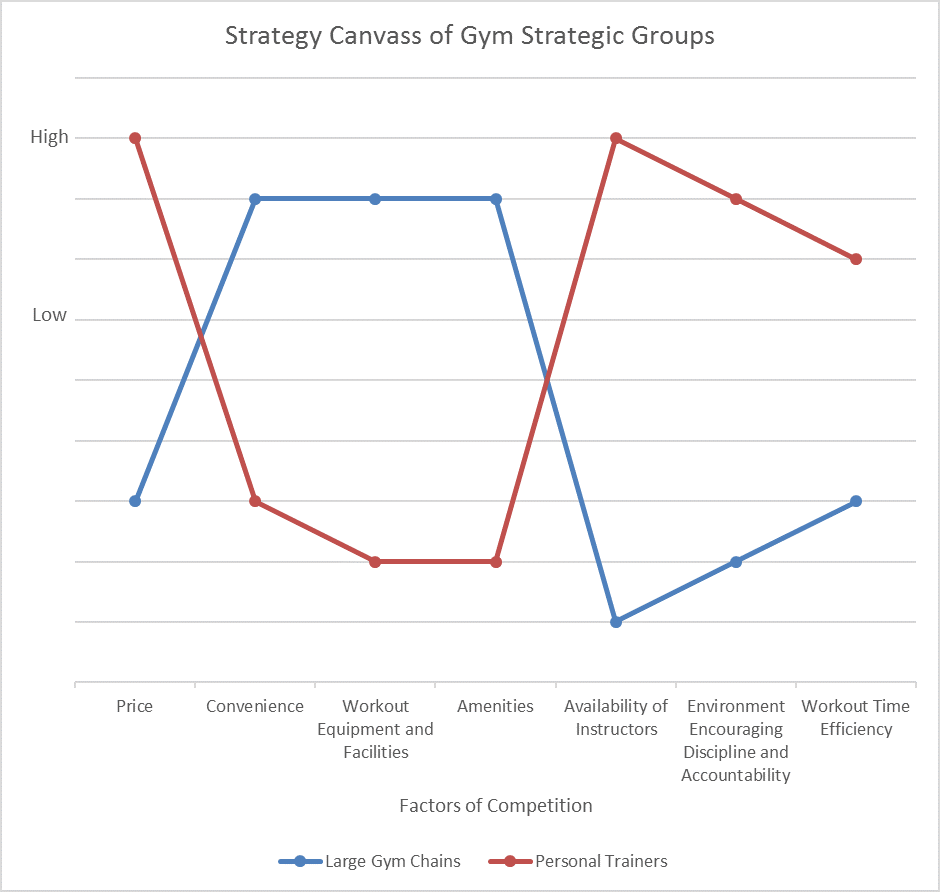Part 4: The Second Path to Discovering a Blue Ocean Idea - CrossFit

This is an example of a "Blue Ocean" business idea. "Blue Ocean" companies are generally much more profitable and successful. For more context see the first three parts of the series here:
CrossFit is an example of a Blue Ocean strategy that looks across strategic groups within an industry. Within the market for customers who exercise at gyms, the low-cost provider strategic group is large gym chains (24 Hour Fitness, Gold’s Gym, Crunch Gym) that provide a myriad of fitness options and methods to their customers for a reasonable monthly fee.
While the facilities in these gyms usually give their members many exercise choices and options, the customers must usually design their own exercise regimen and train without professional, customized guidance.
The strategic group that concentrates on customized performance are personal trainers. They provide individual workout regimens, tailored exercise advice, nutrition and diet information, motivation, accountability, and leadership.
A gym customer will have to pay for this superior service though, usually to the tune of $60 to $100 per hour. Many full-service gyms have personal trainers on staff, but their cost is on top of the $30 to $60 dollars per month membership fee.
Therefore, the cost of using a personal trainer (estimating $75 per hour) for 12 hours per month (three sessions per week) plus gym membership fee (estimating $40 per month) would be $940 per month. This cost is prohibitive for most gym members.
CrossFit’s creators determined that there was a specific customer segment not served by these two general strategic groups. This customer segment was gym members who are: already in fairly good shape, urban and suburban, comfortably middle class and upper-middle class, want camaraderie and motivation, desire personalized instruction, require time convenience and flexibility, and expect superior physical results for their time invested at the gym.
They also determined that this market segment was not particularly interested in fancy equipment, a myriad of exercise options, or extensive amenities. In short, they want personal trainer physical results for something close to gym membership prices.
Factors of Competition for Gym Members
Price – Large gym memberships can usually cost anywhere from $20 per month to over $80 per month. Personal trainers can cost anywhere from $50 per hour to upwards of $100 per hour. If a personal trainer charged $75 per hour, the monthly cost would be $900 for 12 sessions.
Convenience - Large gyms are usually open 16 to 24 hours per day. Personal trainers require clients to make scheduled appointments.
Workout Equipment and Facilities – Large gyms have a wide selection of state-of-the-art exercise equipment and workout facilities. Personal trainers usually have small gyms with limited equipment or they may work as employees/contractors in large gyms.
Amenities – Large gyms usually have a wide range of products and services that they sell along with their fitness value proposition (drinks, supplements, daycare, décor, the latest exercise gadgets…). Personal trainers (if they own their own gyms or equipment) usually offer customized amenities designed to cater to their clientele.
Availability of Instructors – At large gyms, the services of personal instructors are not included in the membership price. Personal trainers are often available for hire, but at rates often ranging from $50 to $100 per hour. Freelance personal instructors, who work at small specialty gyms, often charge more than large gyms charge for their personal trainers.
Environment encouraging discipline and accountability – Large gyms have little leverage or ability to 1) hold their members accountable to a workout routine or regimen, or 2) ensure their members are putting forth adequate effort during their workouts. Personal trainers work by appointment and often remind their clients to stick with their exercise program. They also encourage their clients to maximize their efforts during workouts to receive superior results.
Workout Time Efficiency – Large gyms only offer their clients access to exercise equipment, not instruction on how to use that equipment efficiently to achieve maximum results for their time invested in exercise. Personal trainers excel in this area. They can tailor exercise routines based upon the fitness needs and time available to their clients.

CrossFit’s Blue Ocean Strategy
Factors to Raise:
Price – CrossFit usually costs $150 to $220 per month for unlimited access. This is significantly more than large gym memberships, but far less than the costs of personal trainers.
Availability of Instructors – CrossFit uses a branded exercise method taught in group classes by instructors. CrossFit instructors are able to often give “personal trainer” quality exercise advice to their clients.
Environment Encouraging Discipline and Accountability – CrossFit encourages community and a disciplined exercise ethic. Peer pressure increases workout accountability.
Workout Time Efficiency – CrossFit’s workout method is specifically designed as a high intensity workout that delivers a significant exercise benefit in a limited timeframe.
Factors to Lower:
Convenience – CrossFit’s hours of operation are usually in the early morning (5 am to 9 pm) and in the evening after the work day (5 pm to 8 pm). This is more convenient than by appointment personal trainers, but far less convenient than a large gym’s expansive hours of operation.
Workout Equipment and Facilities – CrossFit uses a small gym format with limited, basic exercise equipment (kettle bells, ropes, tires…).
Factors to Create:
Competition and Camaraderie – CrossFit recognized that the customer segment they cater to thrives on competition and a feeling like they belong to a similarly fitness-minded community.
CrossFit Exercise Method – The CrossFit exercise method was developed over a 20-year period to deliver full spectrum fitness (strength, endurance, balance). It is specifically designed to use basic equipment and requires little exercise space.
Factors to Eliminate:
Amenities – CrossFit gyms are bare bones facilities focused on functionality and delivering their primary value proposition – superior fitness results.

CrossFit’s Blue Ocean strategy allowed it to exploit a hidden market of gym members who wanted 1) to belong to a community of like-minded fitness aficionados and 2) the exercise results that can be achieved through personal trainers, but at a price that is affordable to people with a middle-class lifestyle.




